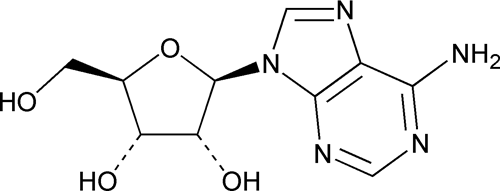Adenosine
(a den' oh seen).
DEFINITION
Adenosine contains NLT 99.0% and NMT 101.0% of C10H13N5O4, calculated on the dried basis.
IDENTIFICATION
• Infrared Absorption  197M
197M :
NMT 0.1%
:
NMT 0.1%
ASSAY
• Adenosine
Sample:
200 mg of Adenosine previously dried at 105 for 2 h
for 2 h
Titrimetric system
(See Titrimetry  541
541 .)
.)
Mode:
Direct titration
Titrant:
0.1 N perchloric acid VS
Endpoint detection:
Potentiometric
Blank:
50 mL of glacial acetic acid
Analysis:
Dissolve in 50 mL of glacial acetic acid and titrate with 0.1 N perchloric acid VS. Calculate the percentage of Adenosine (C10H13N5O4) in the portion taken:
Result = [(V  B) × N × F × 100]/W
B) × N × F × 100]/W
| V | = | = Sample titrant volume (mL) |
| B | = | = Blank titrant volume (mL) |
| N | = | = titrant normality (mEq/mL) |
| F | = | = equivalency factor: 267.25 mg/mEq |
| W | = | = weight of the Sample (mg) |
Acceptance criteria:
99.0%–101.0% on the dried basis
IMPURITIES
• Residue on Ignition  281
281 :
NMT 0.1%
:
NMT 0.1%
• Heavy Metals, Method II  231
231 :
NMT 10 ppm
:
NMT 10 ppm
• Limit of Ammonia
Sample solution:
Suspend 0.5 g in 10 mL of water. Stir for 30 s, and pass through a coarse filter. Dilute the filtrate with water to 15 mL, and use the filtrate.
Standard solution:
0.4 µg/mL of ammonium chloride in water
Analysis:
To the Sample solution and the Standard solution add 0.3 mL of alkaline mercuric–potassium iodide TS, cap the test tubes, and allow to stand for 5 min.
Acceptance criteria:
The Sample solution does not exhibit a more intense yellow color than that of the Standard solution (NMT 4 ppm of ammonia).
• Limit of Chloride
Sample solution:
Suspend 0.2 g in 10 mL of water. Stir for 30 s, pass through a coarse filter, and use the filtrate.
Standard solution:
2.3 µg/mL of sodium chloride in water
Analysis:
To the Sample solution and 10 mL of the Standard solution add 1 mL of nitric acid and 1 mL of silver nitrate TS, and dilute each solution with water to 40 mL. Allow the solutions to stand for 5 min, protected from light.
Acceptance criteria:
When viewed against a dark background, the Sample solution is not more turbid than the Standard solution (NMT 0.007% chloride).
• Limit of Sulfate
Sample solution:
Suspend 0.75 g in 15 mL of water. Stir for 30 s, pass through a coarse filter, and use the filtrate.
Standard solution:
Add 0.15 mL of 0.020 N sulfuric acid to 15 mL of water.
Analysis:
To the Sample solution and the Standard solution add 2 mL of barium chloride TS and 1 mL of 3 N hydrochloric acid, dilute each solution with water to 30 mL, and mix. Allow the solutions to stand for 5 min.
Acceptance criteria:
The Sample solution is not more turbid than the Standard solution (NMT 0.02% sulfate).
• Organic Impurities
Solution A:
6.8 g/L of potassium hydrogen sulfate and 3.4 g/L of tetrabutylammonium hydrogen sulfate in water. Adjust with 2 N potassium hydroxide to a pH of 6.5.
Solution B:
0.1 g/L of sodium azide solution
Mobile phase:
Solution A and Solution B (60:40)
System suitability solution:
0.2 mg/mL each of Adenosine and inosine in Mobile phase
Sample solution:
1.0 mg/mL of Adenosine in Mobile phase
Chromatographic system
Mode:
LC
Detector:
UV 254 nm
Column:
4.6-mm × 25-cm; 5-µm packing L1
Flow rate:
1.5 mL/min
Injection size:
20 µL
System suitability
Sample:
System suitability solution
Suitability requirements
Resolution:
NLT 9.0 between adenosine and inosine
Tailing factor:
NMT 2.5
Relative standard deviation:
NMT 2.0%
[Note—Chromatograph the Sample solution, and adjust the run time to at least twice the retention time of the major peak. ]
Analysis
Sample:
Sample solution
Calculate the percentage of each impurity in the portion of Adenosine taken:
Result = (rU/rT) × 100
| rU | = | = peak response of each impurity from the Sample solution |
| rT | = | = sum of all the responses for all peaks from the Sample solution |
Acceptance criteria
Individual impurities:
NMT 0.1% each of guanosine, inosine, and uridine, and NMT 0.2% of adenine
Total impurities:
NMT 0.5%
SPECIFIC TESTS
• Melting Range or Temperature  741
741 :
233
:
233 –238
–238
• Optical Rotation, Specific Rotation  781S
781S :
:
 68
68 to
to  72
72
Test solution:
20 mg/mL in sodium hydroxide solution (1 in 20), determined on a sample previously dried at 105 for 2 h
for 2 h
• Acidity or Alkalinity:
Suspend 1 g in 20 mL of carbon dioxide-free water. Stir for 30 s, and pass through a coarse filter. To each of two 10-mL portions of the filtrate add 0.1 mL of bromocresol purple TS.
Acceptance criteria:
NMT 0.3 mL of 0.01 N sodium hydroxide is required to produce a blue-violet color in one portion. NMT 0.1 mL of 0.01 N hydrochloric acid is required to produce a yellow color in the other portion.
• Loss on Drying  731
731 :
Dry a sample at 105
:
Dry a sample at 105 for 2 h: it loses NMT 0.5% of its weight.
for 2 h: it loses NMT 0.5% of its weight.
ADDITIONAL REQUIREMENTS
• Packaging and Storage:
Preserve in tight, light-resistant containers, and store at controlled room temperature.
Auxiliary Information—
Please check for your question in the FAQs before contacting USP.
| Topic/Question | Contact | Expert Committee |
|---|---|---|
| Monograph | Ravi Ravichandran, Ph.D.
Principal Scientific Liaison 1-301-816-8330 |
(SM42010) Monographs - Small Molecules 4 |
| Reference Standards | RS Technical Services 1-301-816-8129 rstech@usp.org |
USP35–NF30 Page 2079
Pharmacopeial Forum: Volume No. 29(6) Page 1834

